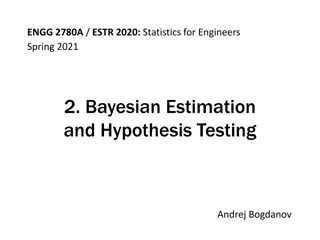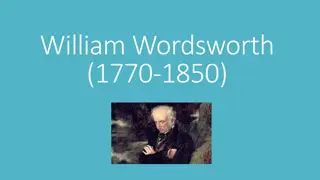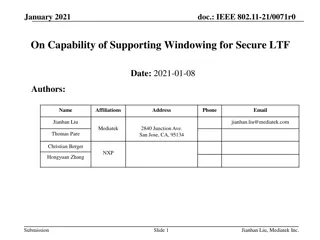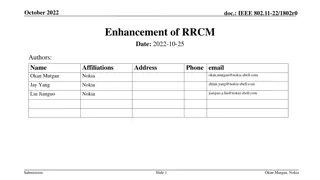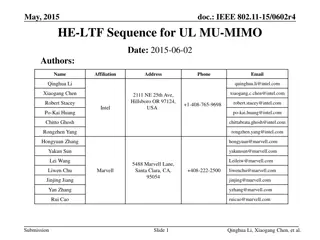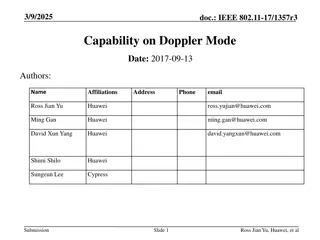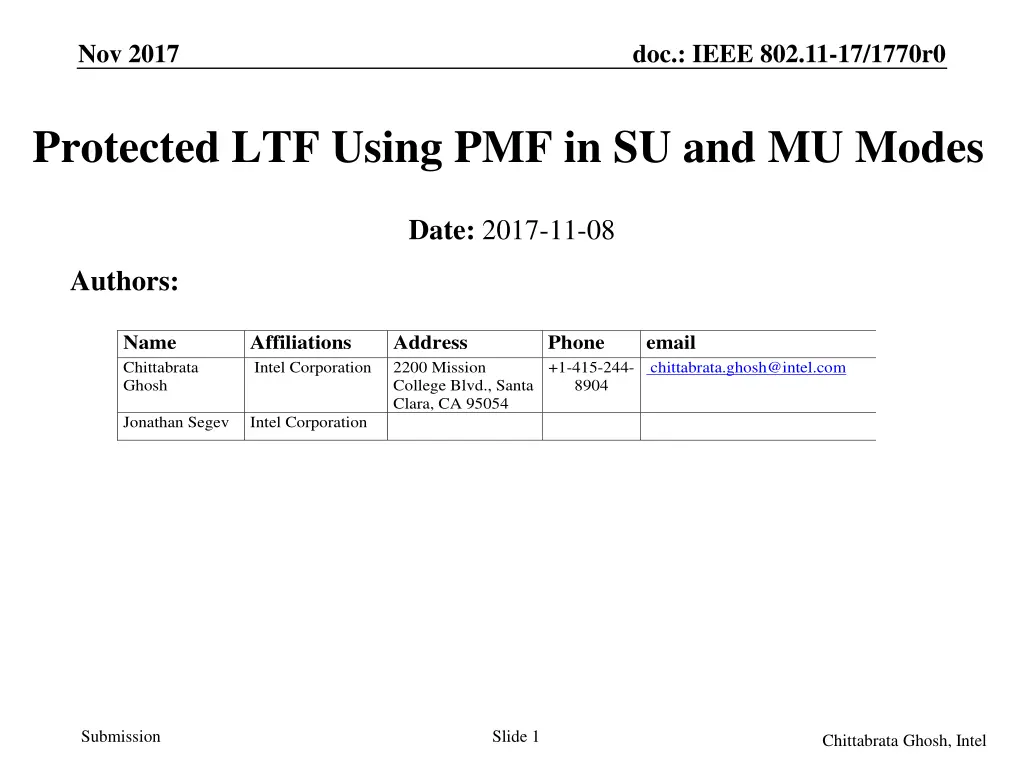
Protected LTF Using PMF in SU and MU Modes
In this IEEE presentation, Chittabrata Ghosh from Intel discusses LTF protection in both SU and MU modes, emphasizing its relation to MAC security and security negotiation. The presentation explores key exchange in negotiation phases and randomization seed in measurement phases for enhanced security.
Download Presentation

Please find below an Image/Link to download the presentation.
The content on the website is provided AS IS for your information and personal use only. It may not be sold, licensed, or shared on other websites without obtaining consent from the author. If you encounter any issues during the download, it is possible that the publisher has removed the file from their server.
You are allowed to download the files provided on this website for personal or commercial use, subject to the condition that they are used lawfully. All files are the property of their respective owners.
The content on the website is provided AS IS for your information and personal use only. It may not be sold, licensed, or shared on other websites without obtaining consent from the author.
E N D
Presentation Transcript
Nov 2017 doc.: IEEE 802.11-17/1770r0 Protected LTF Using PMF in SU and MU Modes Date: 2017-11-08 Authors: Name Chittabrata Ghosh Affiliations Intel Corporation Address 2200 Mission College Blvd., Santa Clara, CA 95054 Phone +1-415-244- 8904 email chittabrata.ghosh@intel.com Jonathan Segev Intel Corporation Submission Slide 1 Chittabrata Ghosh, Intel
Nov 2017 doc.: IEEE 802.11-17/1770r0 Abstract In this presentation, we discuss about the LTF protection for both SU and MU ranging and its relation to the MAC security and security negotiation Key exchange in negotiation phase Randomization seed in measurement phase Submission Slide 2 Chittabrata Ghosh, Intel
Nov 2017 doc.: IEEE 802.11-17/1770r0 Introduction In previous discussions we agree on the following: The HEz and VHTz FTM modes, the fields over which range measurements are performed shall be protected against a VHT/HE Type B adversary attack. For the purpose of PHY Security Mode, the field used for channel/ToA measurement shall not include any form of repetition in time domain or structure that is predictable. In this submission we will review possibilities of signaling between iSTA and rSTA that enables LTF protection. Submission Slide 3 Chittabrata Ghosh, Intel
Nov 2017 doc.: IEEE 802.11-17/1770r0 Existing Proposal 1: Exchanging Keys in UL and DL NDP [1] iSTA indicates Key 1 in UL NDP frame and rSTA indicates Key 2 in DL NDP frame Existing proposal has following limitations: Requires intended receiver to buffer the samples of the sounding (UL NDP and DL NDP) till results of the decoded key complete the entire Rx path: Creates a bottle neck and large buffers at the receiver side. Especially problematic for Immediate RSTA as LMR results generation now have shorter time (time is cut down by LTF processing time following the Key1 decoding). Requirement to have a separate Rx path for key and sounding creates complexity Limits ability to reuse existing baseband as the 802.11ax and 802.11ac sounding waveforms (DL NDP frame) does not include data field. Submission Slide 4 Ghosh Chittabrata, Intel
Nov 2017 doc.: IEEE 802.11-17/1770r0 Existing Proposal 2: Inserting Keys in NDPA frame [1] rSTA indicates Key 1 and Key 2 in the NDPA frame However, 802.11 control frames does not support encryption Creates critical path at the receiver side between the decryption process (normally involved bit crunching) and likely to require the sounding waveform (UL NDP) samples to be buffered until the decryption process completes Layer boundary violation (PHY needs to do decryption) to meet the timing constraints. Hard on immediate RSTA that will need to decrypt prior to CE not good for the technology and market. Not replay attack protected unlike PMF. Submission Slide 5 Chittabrata Ghosh, Intel
Nov 2017 doc.: IEEE 802.11-17/1770r0 Proposed Key Exchange in Negotiation and LTF Randomization in Measurement Phases in SU Mode ISTA RSTA Key exchange and establishment between iSTA and rSTA in the non-time critical negotiation phase reusing PMF scheme. Initialization vector or Packet Number (PN) for both UL and DL in NDPA frame by the iSTA The iSTA LTF sequence in UL NDP is derived out of the established key in negotiation phase and the UL PN in NDPA frame The rSTA LTF sequence in DL NDP is derived out of the established key in negotiation phase and the DL PN in NDPA frame PN is transmitted in the clear no encryption in control frames. PN selection follows same rules as PMF. Negotiation/key exchange NDPA (UL PN, DL PN) UL NDP LTF = f(key, UL PN) DL NDP LTF = f(key, DL PN) LMR Submission Slide 6 Chittabrata Ghosh, Intel
Nov 2017 doc.: IEEE 802.11-17/1770r0 Option 1: UL and DL PNs in TF in MU Mode Same key exchange and establishment as SU between iSTA and rSTA in negotiation phase again reusing PMF scheme for key generation, establishment and refresh. Initialization vector or Packet Number (PN) for both UL and DL are included in the Trigger frame transmitted by the RSTA The iSTA LTF sequence in UL NDP is derived out of the established key in negotiation phase and the UL PN in TF frame for UL sounding. The rSTA LTF sequence in DL NDP is derived out of the established key in negotiation phase and the DL PN in TF. Submission Slide 7 Chittabrata Ghosh, Intel
Nov 2017 doc.: IEEE 802.11-17/1770r0 Option 2: UL PN in TF / DL PN in NDPA Same key exchange and establishment as SU between iSTA and rSTA in negotiation phase again reusing PMF scheme for key generation, establishment and refresh. Initialization vector or Packet Number (PN) for UL in TF and for DL in NDPA frame by the iSTA The iSTA LTF sequence in UL NDP is derived out of the established key in negotiation phase and the UL PN in NDPA frame The rSTA LTF sequence in DL NDP is derived out of the established key in negotiation phase and the DL PN in NDPA frame Polling part Position (FTM) Sounding part Polling larger # of STA for resource request. Identify the STA require meas. UL NDP STA n Tx m Location Meas. Report DL NDP NDPA (location) Per STA Info ([RID STA 1, DL PN] .[RID STA n DL PN]) TF (location) Per STA Info ([RID STA 1, UL PN] .[RI D STA n UL PN]) UL NDP SIFS SIFS SIFS SIFS SIFS Single availability window Submission Slide 8 Chittabrata Ghosh, Intel
Nov 2017 doc.: IEEE 802.11-17/1770r0 Advantages of the Proposed Mechanism of Key Exchange Security context negotiation and establishment using PMF in the unassociated mode already agreed for MAC level security Extending PMY scheme for PHY level security and generation of LTFs are simple and straight forward Use of Packet Number (PN) as a seed for LTF sequence/secured property generation allows use of control frames (NDPA or Trigger frame) avoiding encryption of control frames. Inclusion of both the UL and DL PN in the preceding control frame allows for use of existing frame types and formats without the need of introducing a new frame format for the NDP (inclusion of PN without data field) The Location Measurement Reporting (LMR) can still use the PMF protection that 11az expects to extend to the unassociated mode Fits well to both SU and MU protect schemes Submission Slide 9 Chittabrata Ghosh, Intel
Nov 2017 doc.: IEEE 802.11-17/1770r0 Summary In this contribution, we have presented the existing proposal on key exchange for PHY level security We have proposed a new mechanism of key exchange by reusing the PMF scheme The key exchange and establishment are executed in the negotiation phase Initialization vector or PN for UL and DL are signaled in the measurement phase In SU mode, the UL and DL PNs are indicated in the NDPA frame by the iSTA In MU mode, the UL and DL PNs are either indicated in the Trigger frame in one option and in another option, UL PN indicated in TF and DL PN indicated in NDPA frame Submission Slide 10 Chittabrata Ghosh, Intel
Nov 2017 doc.: IEEE 802.11-17/1770r0 Reference [1] 11-17-1726r0, Secure ranging measurement, Yongho Seok Submission Slide 11 Chittabrata Ghosh, Intel

